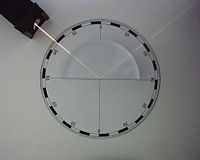Total Internal
Reflection
When a ray of light
passes from a denser medium (glass) to a rarer medium (air),the refracted ray bends away from the normal and the angle of refraction is greater than the
angle of incidence.
As the angle of
incidence I increases,the anlge of refraction r also increases in a way that r
is always greater than i.till for a particular value of angle of incidence,the
corresponding angle of refraction become 90 degrees and the refracted ray
grazes along the surface.
“The angle of
incidence in the denser medium for which the corresponding angle of refraction
is 90 degrees in the rarer medium is called the critical angle”C”.
This angle of incidence/Critical angle is denoted by “C” .
This angle of incidence/Critical angle is denoted by “C” .
When the value of the
angle of incidence becomes greater than the critical angle,then the ray does not
pass into the second medium (air),that is the ray of light no longer undergoes
refraction,but are totally reflected back in the denser medium eg (glass) obeying
the laws of reflection.
Such reflection of light is termed as “Total Internal Reflection”.
There are two conditions
that must exist for total internal reflection:
1.The ray of light
should travel from a denser medium to a rare medium.
2.The angle of
incidence should be greater than the critical angle.
Critical Angles of Different Materials:
Glass
42 degrees
Water 49 degrees
Diamond 24 Degrees


1.Total internal reflection can be seen at the air-water boundary.

2.Total internal reflection in a block of acrylic

3.Total internal reflection in a semi-circular acrylic block
Images from Wikipedia
No comments:
Post a Comment